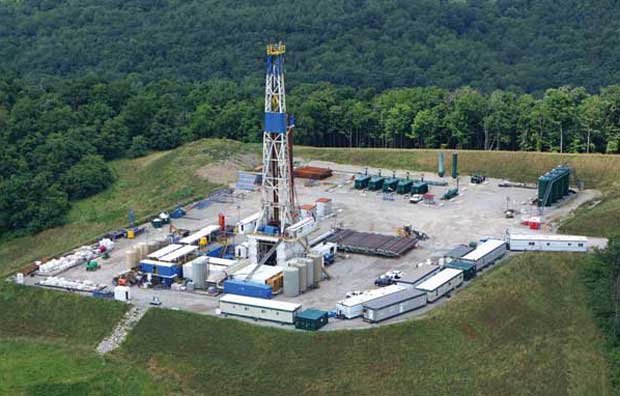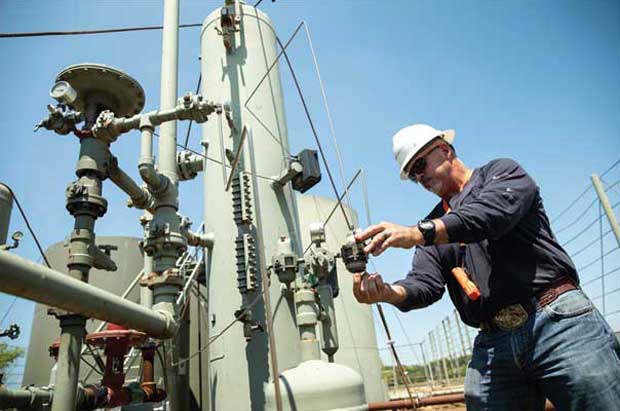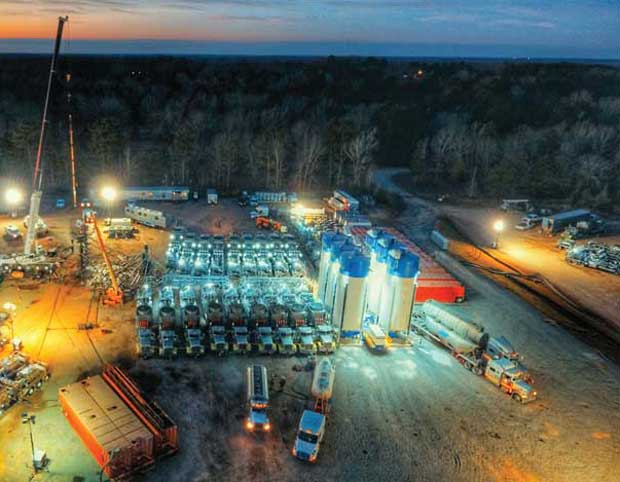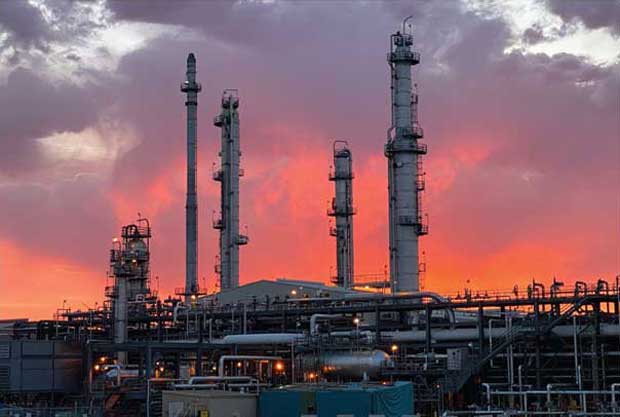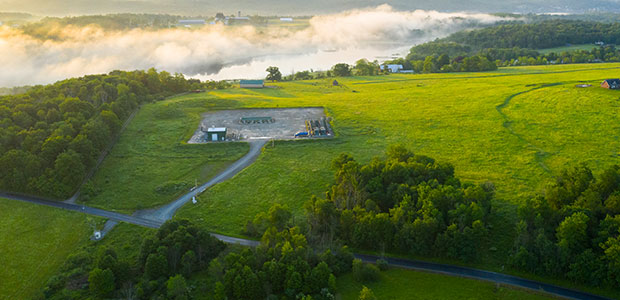
Stronger Fundamentals Giving Gas Producers Upside Opportunities
By Al Pickett and Danny Boyd
With natural gas prices averaging their highest levels in years over the summer months, gas-weighted operators are seeing lots of reason for optimism as the market steadily marches toward a new winter heating season.
“It is starting to feel like a gentle breeze at our back instead of a West Texas wind in our face,” says Dennis Degner, chief operating officer of Range Resources Corp. “It is a lot more encouraging compared to six or 12 months ago.”
Natural gas prices exited August above $4.00 an MMBtu and December futures were in the $4.40/MMBtu range, giving operators not only immediate upside price capture opportunities, but expectations for rising prices going forward translate to higher-value hedge positions down the road. By comparison, Eric Jacobsen, chief operating officer of Denver-based BKV Corp., notes that Henry Hub prices were only around $1.70/MMBtu last spring and into the summer when BKV was preparing to close on its acquisition of Devon Energy Corp.’s position in the Barnett Shale.
“Natural gas is in a much better place than it was a year ago,” he relates. “Structurally, the market looks strong.”
The Barnett, of course, is the original horizontal gas shale play, and BKV’s assets include some of the original acreage where first Mitchell Energy and then Devon Energy perfected the science of shale development. In Appalachia, Range Resources played the pioneering role, drilling the Renz No. 1 Marcellus discovery well in 2004. In both plays, higher natural gas prices–and more importantly, the stronger fundamentals underlying them–have producers feeling more upbeat about the future than they have in a good, long while.
A higher gas price deck is only part of the good news, however. For producers in plays with liquids-rich gas, which include parts of both the Marcellus/Utica and Barnett, natural gas liquids are also providing stronger profit margin opportunities.
Three-quarters of Range’s 460,000 net acres in southwestern Pennsylvania produce wet gas, making NGLs a historically significant component for the company. “NGLs are a big part of the Range story,” Degner explains. “Propane is now well north of $1 per gallon, or over $40 per barrel, which equates to a natural gas-equivalent price of approximately $7. Thirty percent of our production is liquids, but that means in excess of 40% of our revenue. Every dollar of improvement in NGL pricing means $30 million to our annual cash flow.”
He says Range’s NGL price is forecasted to increase by $14 per barrel in 2021 versus 2020 prices, translating to more than $400 million in incremental cash flow for the company. “Higher NGL prices are incredibly impactful,” Degner contends.
In the second quarter, Range began utilizing an additional 5,000 bbl/d of the capacity on the Mariner East pipeline to transport NGLs to export markets. Degner points out that Range’s second-quarter NGL price benefitted from a diversified marketing strategy with flexibility in product placement and sales timing. It has the flexibility of shipping its NGLs by rail to East Coast markets in addition to using Mariner East to export its barrels to Europe and Asia.
As an example of what that strategy means for the company, Range’s unhedged realized NGL price for the second quarter was $27.92/bbl, a $2.24 premium to Mont Belvieu. This represents the highest premium to Mont Belvieu in company history, according to Degner, and the highest quarterly NGL price since 2014. Prices have increased even further since the second quarter–to over $30 per barrel currently.
Higher Absolute Prices
According to Range’s 2Q report, the company expects strong fundamentals to result in higher absolute prices for domestic propane and butane in the second half of 2021.
“Coupled with a lighter barrel from export timing and seasonality in domestic NGL sales, Range expects lower premiums to Mont Belvieu in the second half of 2021 but improving overall NGL price realizations in a globally competitive price environment,” the report states. “Range’s 2021 premium NGL prices show the benefit of a diversified NGL portfolio and access to international markets.”
While Range’s 2021 activity profile may be weighted toward the liquids-rich play, Degner says dry gas production still remains an equally important part of Range’s portfolio.
“Forty percent of our activity will be dry gas this year,” he points out. “But historically it has been 30%-50%, so that is not out of the ordinary. We have always leaned toward the liquids-rich play by design.”
Three-quarters of Range Resources’ 460,000 net acres in southwestern Pennsylvania produce wet gas, making NGLs a big part of the Range story. Thirty percent of its production is liquids, and every $1 of improvement in NGL pricing means $30 million to Range’s annual cash flow. With Range’s NGL price forecast to increase by $14 a barrel in 2021 versus 2020 prices, the higher price translates to more than $400 million in incremental cash flow for the company.
Range, which has about 1,200 wells in production in southwestern Pennsylvania, is continuing to push lateral lengths. Degner says the laterals on Range’s wells will average 10,000-12,000 feet this year, although it successfully drilled a 19,000-foot lateral in the first quarter.
“We have more than 60 wells in excess of 15,000 feet,” he adds. “It is a balancing act to what fits best with your gathering system. To be successful, you have to be repeatable.”
Even though Range has been successfully developing the Marcellus shale since 2004, there is plenty of work left to do. “We have 3,100 undrilled Marcellus locations, 2,600 in the liquids-rich inventory and 500 in the dry gas window,” Degner offers. “We will drill around 60 wells this year. At that rate, we have several decades of drilling remaining.”
The company estimates 2,000 of the undrilled Marcellus locations have estimated ultimate recoveries of 2 billion cubic feet equivalent or better per 1,000 feet of lateral. And that’s not all. Much of Range’s footprint in southwestern Pennsylvania includes the Utica and Upper Devonian, which lie below and above the Marcellus, respectively.
“But our focus is almost exclusively on the Marcellus,” Degner maintains. “We are encouraged by the Utica, and we believe some of the core top-tier Utica lies under our Marcellus acreage. We will continue to map out the Utica horizon reservoir, and with our large Marcellus inventory we can be patient in the Utica and can monitor the industry. With 1,200 wells, the Marcellus is our bread and butter. It is the greatest gas field in North America.”
Degner says he is also proud of Range’s environmental, social, governance efforts, including its water recycling and emission reductions.
“We have a pilot project to further study the data of what our operations mean as far as emissions,” he explains. “Emissions are similar to production. If we can measure it, we can improve it. We are able to recycle nearly 150% of our water because we are taking water from other operators. This is a great story. We are reducing the supply needed for freshwater.”
Because of the strong future strip prices for 2022 and 2023, Degner believes Range’s approach will one of “steady goes the ship” rather than expansive growth.
“I don’t see the market rewarding production growth,” he emphasizes. “We feel like we can reach our target and grow cash flow per share at a maintenance level without having to grow production.”
Taking It To The Next Step
BKV closed its acquisition of Devon’s assets in the Barnett Shale in North Texas last October. “I can’t say enough about what a great seller Devon was to work with or about the high quality work Devon did in the Barnett,” Jacobsen lauds.
George Mitchell worked for years to come up with the right recipe for hydraulically fracturing the shale. After acquiring Mitchell Energy, Devon further revolutionized the development process by introducing horizontal drilling with transverse fracturing in the Barnett. “Devon did a great job following Mitchell, and now we are going to take it the next step,” Jacobsen claims.
Because much of what was initially drilled in the Barnett was in the early pioneering phase of the play, Jacobsen says there is “a lot of meat left on the bone.” Therefore, BKV has a unique plan to re-enter a large number of existing wells with a restimulation and refracturing program.
For example, Jacobsen says many of the laterals had 200-500 feet between perforation clusters. BKV will go back in, bringing clusters as close as 20-60 feet.
The Barnett was the original gas shale play. Because many of BKV’s Barnett wells were drilled and completed 15-plus years ago during the early days of the shale revolution, they offer significant upside potential for restimulating with modern frac designs. BKV implemented a restimulation program in the Barnett earlier this year, and plans to begin a new drilling program in the first quarter of next year targeting lateral lengths of 8,000-10,000 feet.
“We have 10 years of inventory available to keep our production flat, which we will exploit pending commodity prices and other factors,” he maintains. “That will generate a lot of cash flow with flat production to even slight growth. No one will be rewarded by outspending their cash flow.”
The company’s restimulation and refracturing program has been underway for about four months, and BKV is set to add a second frac crew. Jacobsen says it is using a spectrum of innovative frac designs, from smaller to medium to large.
“We like what we are seeing,” he adds, noting it is still too early to put quantitative numbers on the project. “But I can say the best-case scenario so far of our restimulation and refracturing program has produced 10 times the previous base production.”
A lot of factors go into determining the design for each individual well. “We are doing it on a pad basis,” he states. “We are evaluating current wellbores, their producing history, offset wells and the cluster design of current wells, in our planning cycle. In the early days, they were in the learning mode. Now, we can look back and determine what job works best. Now we are in a continuous learning mode and rapid application ourselves. We are honed in on data and technology.”
He notes that most existing pads in the Barnett have two-five wells each. Although much of the Barnett lies in the urban Dallas-Fort Worth metroplex, Jacobsen says the majority of BKV’s acreage is in Texas’ more rural Wise and Denton counties north of the metroplex.
While he admits that what BKV is doing with its refrac program could be a blueprint for what the future may hold for other basins, Jacobsen contends that the distinct advantage it has is that much of the Barnett was drilled and completed in the earliest days of the shale revolution.
“A lot of wells in other basins may not have as much untouched rock as we have in the Barnett,” he offers.
In addition to refracs, BKV has plans to begin a new drilling program as early as next year. Jacobsen says it has 300 long laterals (8,000-10,000 feet) left to drill. “We like what we see,” he enthuses.
BKV is the 17th largest natural gas producer in the country with approximately 370,000 gross acres in the Barnett and the Marcellus in northeastern Pennsylvania. Jacobsen says its Pennsylvania acreage is strictly dry gas, while its Barnett Shale position in North Texas has the advantage of being a rich gas. The company is producing nearly 700 MMcfe/d (25% NGLs and 75% dry gas total. Its NGLs are sent to Mont Belvieu and other Texas Gulf Coast markets.
“We have really fantastic marketing and pricing outlets in Texas.” he notes.
Barnett Gas To Power
BKV Corp. announced in August that it was acquiring a Texas power generator for $430 million in a move that leveraged its gas production to generate electricity. BKV is purchasing a 758-megawatt facility in Temple, a couple of hours south of Dallas-Fort Worth, from a 50/50 joint venture with Banpu Power.
“We have had our eye on the Temple plant for some time. This will be an integrated value chain, taking wellhead gas to electricity in people’s homes,” Jacobsen details. “Our goal will be a closed-loop, net carbon neutral gas supply to electricity end users. We intend to ultimately sell green gas with the goal of achieving net zero carbon emissions.”
The deal, which is expected to close in the fourth quarter, comes as Texas tries to encourage new gas-fired power generation to meet record demand. Many of Texas’ coal-fired plants have closed due to competition from cheaper wind and solar, leaving the state facing shortages during extreme heat and cold events.
Of course, millions of Texans shivered in February when a record cold snap and snow and ice storm left many in the state without lights and heat as the Texas electric grid failed. The Central Texas plant, which provides enough electricity to power 750,000 homes, was one of the few facilities that stayed in service during the February freeze-out.
“I am so proud of our operating team,” Jacobsen lauds. “We were able to safely keep a decent level of production during the storm to keep people’s homes warm. We have been told that we had more success in keeping our production up than most other companies. I could not be prouder of our team.”
Jacobsen also maintains BKV is a leader in ESG, and plans to use solar and other technology to power its well pads. He says it is very possible that the company will reach Net Zero Scope I and II by the end of 2023 and that is exactly what it aspires to do. He adds that BKV also thinks it is possible to deliver green gas and green power with Net Zero Scope III by 2030. It believes the company can achieve both of these goals primarily organically as well, according to Jacobsen, rather than purchasing carbon credits.
The Temple plant was built in 2014 and is equipped with advanced emissions-control technology, which will enable BKV to certify its carbon emissions footprint, he concludes.
Compelling Economics
Hedges on much of Rockcliff Energy LLC’s 1 Bcf of daily gas output from the Haynesville Shale allowed the private Houston-based company to protect drilling economics and capital and avoid laying down rigs and cutting staff during 2020, says Boyd Heath, chief financial officer and co-founder. And now with strong fundamentals in the U.S. market, Rockcliff is positioned to reap the rewards of its steady drilling and development approach.
Rockcliff is enjoying not only higher returns on unhedged output, but market proximity and a midstream partnership to further reinforce its Haynesville Shale sales to Gulf Coast distribution centers serving industrial customers, petrochemical complexes, LNG exporters and Mexican export pipelines, among others, he says.
“The Haynesville is a very attractive place to be,” Heath comments. “The economics are very compelling, and I think the market is recognizing that.”
Rockcliff is leveraging a number of advanced drilling, completion and production technologies to optimize the bottom-line performance of its Haynesville Shale wells. The list includes managed pressure drilling, automated sliding, real-time torque and drag analysis, casing flotation systems, dissolvable frac plugs, artificial intelligence-based algorithms to predict well performance, fiber optics-enabled perforation analysis cameras, SCADA software, and emissions monitoring systems.
Announced multibillion dollar deals that include Southwestern Energy’s pending acquisition of Indigo Natural Resources and Chesapeake Energy’s pending purchase of Vine Energy offer further proof of the Haynesville’s long-term economic viability, he says.
Rockcliff’s East Texas acreage position, free cash flow status, and sales arrangements position the company for continued solid growth, Heath adds.
Through a partnership with Trace Midstream (co-founded by Rockcliff and its lead investor, Quantum Energy Partners), the company’s gas flows into long-haul pipelines that supply the Houston Ship Channel, other Texas Gulf Coast outlets, the Perryville hub in northeast Louisiana and LNG terminals at Stark and Gillis, La., he explains. The company also has talked to LNG buyers about direct sales, he adds.
Rockcliff continues to add acreage and working interest percentages through grassroots efforts and trades with Haynesville peers and is able to self-fund its work developing 156,000 net acres prospective of the Haynesville out of an overall 270,000 net-acre position, Heath explains.
The company became free cash flow positive in the second quarter, he says. In late August, its total debt was 1.3 times EBITDA, but is expected to decline below 1.0 times EBITDA by the end of the year, Heath says.
“We have a very healthy balance sheet, which is a result of outstanding rock, great economics and a great execution team,” he says.
The company continues to exploit its acreage in Harrison and Panola counties in Texas. Since earlier this year, average lateral lengths have extended from 9,000 feet to nearly 10,000 feet with several laterals exceeding 12,000 feet, Heath reports. Completions typically are sized with ±3,500 pounds per foot of proppant and 85-100 barrels of water per foot, Heath details.
Paramount To Success
Advanced drilling and completion technologies are paramount to success in the play, Heath says. Rockcliff utilizes managed pressure drilling, casing flotation systems, and dissolvable frac plugs, among other solutions to optimize drilling and completion performance, he says.
“We also utilize automated sliding and real-time torque and drag analysis,” Heath continues. “You want to make sure your wellbore and your pipe are going where you want them to go. You want to ensure less friction to improve efficiency and ensure you can case the wellbore you have drilled.”
Software programs provide real-time information aggregated for analysis, and with the use of artificial intelligence, an internally developed algorithm provides information quickly to predict well performance and optimize overall development, he says.
“We are running four rigs consistently with two completion crews, so the faster we can get the data and analyze it, the better informed we are for the next capital spend,” Heath remarks. “We are absolutely continuing to push the technology forward to enhance drilling and completion efficiencies and minimize cost.”
Utilizing a retrievable fiber optics system and perforation analysis camera downhole, Rockcliff’s team is able to evaluate completion efficiency and optimize their designs, he says.
SCADA software enables the company to gather its production data from all its wells throughout is entire asset base, including production of gas, liquids and water.
In addition to drilling and completion performance, ESG performance is a major focus, Heath says. To monitor and reduce emissions, Rockcliff has partnered with industry-leader Project Canary to deploy an active emissions monitoring system across the company’s Haynesville development.
In 2020, Rockcliff’s methane emissions intensity rate was 0.13%, which was 54% below One Future’s 2025 goal and 35% below Oil and Gas Climate Initiative’s 2025 goal, he points out. Green completions eliminate venting and flaring, and 90 percent of flowback and produced water is piped, eliminating some 700 truckloads a day, or roughly 12,000 road miles, Heath says. Bifuel frac fleets reduce diesel consumption significantly and all four drilling rigs will be bifuel by year end, he adds.
Altogether, the company continues to drill faster and more efficiently, he says, boring more footage every year and more year-to-date than the company’s original plan called for.
“We are blessed with great rock, a healthy balance sheet, and a substantial amount of quality inventory for many years to come,” Heath concludes.
New Age Dealmaking
In late May, Cabot Oil & Gas and Cimarex Energy Co. announced an all-stock merger of equals that may signal a new era in corporate merger and acquisition trends. The deal combines two leading operators with top-tier acreage that is far from contingent, or even produces the same form of hydrocarbons. Cabot’s portfolio has long been focused on Marcellus Shale gas while Cimarex’s portfolio is concentrated in Permian and Mid-Continent tight oil plays. Together, the new company has a diversified asset base in premiere domestic oil and gas basins, Dan O. Dinges, chairman, president and CEO of Cabot said at the time of the announcement.
“The combination of Cabot and Cimarex creates a free cashflow-focused, diversified energy company with the scale, inventory and financial strength to thrive across commodity price cycles,” Dinges remarked. “With its premier assets, increased resource diversity and a strong financial foundation, the company will be well positioned to deliver long-term value creation for its shareholders and other stakeholders.”
Thomas E. Jorden, chairman, president and CEO of Cimarex, added: “This transformational merger will combine our top-tier assets and advance our shared focus on delivering superior returns. We view commodity, geography and asset diversification as strategic advantages that will drive more resilient free cash flow and long-term value creation. We are aligned on our commitment to ESG and sustainability, and look forward to bringing our talented teams together to unlock the tremendous potential of this compelling combination.”
With Cabot’s 173,000 net acres in the Marcellus Shale and Cimarex’s 560,000 net acres in the Permian and Anadarko basins, the combined business has a multidecade inventory of high-return development locations in America’s most production resource plays. Upon closing in the fourth quarter, Dinges will serve as executive chair of the board of directors and Jorden will serve as CEO and board member of the combined business, which will operate under a new name from its Houston headquarters.
Conventional Gas Acquisition
Acquiring natural gas reserves remains a staple for Houston-based Contango Oil & Gas Company, which continues to focus on purchasing existing reserves, improving production and cutting costs as it continues to add to a position in the Permian, western Anadarko and elsewhere.
“For Contango, the near term growth strategy is focused primarily on the acquisition of PDP-heavy assets at attractive valuations and our operational focus is all about enhancing production through workovers, restoring to production acquired wells that were shut in by previous owners due to limited funds, and cutting costs, all of which are designed to significantly enhance already good returns,” says CFO E. Joseph Grady.
In July, the company announced plans to spend $67 million for low-decline conventional gas assets from ConocoPhillips in the Wind River Basin of Wyoming.
In July, Contango announced a $67 million acquisition of low-decline rate conventional gas assets from ConocoPhillips in the Wind River Basin of Wyoming. With closing expected in the third quarter, net production of the acquired assets was 78 MMcfe/d as of July 1 with 446 Bcfe of proved, developed and producing reserves.
With closing expected in the third quarter, the acquisition represents a discount to the proved producing reserve value of the asset, according to Contango. Net production as of July 1 was 78 MMcfe/d, which would boost Contango’s daily output by 57% in the third quarter, the company offers.
Production decline in the Wind River wells is estimated at only 5% a year over the next five years, according to Contango, with significant upside potential, given the company’s track record of optimizing cash flow and reserves on acquired assets. The acquisition gives Contango an additional 446 Bcfe of proved, developed producing reserves.
The Wind River acquisition is not the only one for Contango this year. The company also closed on the acquisition of Mid-Con Energy Partners in January, and in February, closed on a $58 million purchase of Project Silvertip assets in the Big Horn, Permian and Powder River basins.
“The acquisition of these Wind River Basin assets is yet another step in our consolidation strategy and an excellent fit to our asset profile,” states Contango CEO Wilkie S. Colyer. “This is a huge conventional gas field with a low decline profile that was purchased at an attractive valuation. We are intimately familiar with the area via assets acquired in the MCEP and Silvertip transactions, and we have the right team to maximize the value of these mature, low-decline conventional properties.”
For the second quarter, Contango reported average production of 24,100 boe/d, up from 16,100 boe/d for the same period of 2020, with the increase primarily attributable to new production from the Mid-Con and Project Silvertip acquisitions.
In June, Contango announced an all-stock merger with Independence Energy to “create a premier U.S. independent oil and gas company. The merger is expected to close in the fourth quarter, with Independence shareholders owning approximately 76% and Contango shareholders owning 24% of the combined company.
“Our merger with Independence was designed to accelerate our acquisition pace rather than slow it down, and this transaction is a perfect example of that,” Colyer says. “We look forward to closing this transaction and continuing ConocoPhillips’ excellent stewardship of these assets.”
The combined company will be headquartered in Houston and expects to operate under a new name and ticker symbol. The combined company intends to seek listing on the New York Stock Exchange as part of the transaction.
The combined business will be managed by the KKR Energy Real Assets team and led by David Rockecharlie, head of KKR Energy Real Assets, who will serve as chief executive officer. Contango’s chairman and largest shareholder, John Goff, will be chairman of the board. Colyer and Contango President Farley Dakan will continue managing Contango as an operating subsidiary of the combined company and focus on growth through acquisitions, Colyer concludes.
For other great articles about exploration, drilling, completions and production, subscribe to The American Oil & Gas Reporter and bookmark www.aogr.com.







